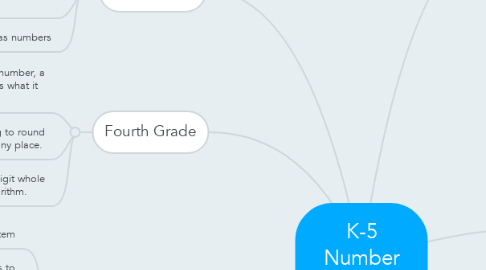K-5 Number Curriculum
by Bree Cowan

1. Third Grade
1.1. Use place value understanding to round whole numbers to the nearest 10 or 100.
1.2. Multiply one-digit whole numbers by multiples of 10 in the range 10-90
1.3. Devolving the idea of fractions as numbers
2. Fourth Grade
2.1. Recognize that in a multi-digit whole number, a digit in one place represents ten times what it represents in the place to its right.
2.2. Use place value understanding to round multi-digit whole numbers to any place.
2.3. Fluently add and subtract multi-digit whole numbers using the standard algorithm.
3. Fifth Grade
3.1. Understanding the place value system
3.2. Read, write, and compare decimals to thousandths.
3.3. Fluently multiply multi-digit whole numbers using the standard algorithm.
3.4. Adding and subtracting fraactions
4. Kindergarten
4.1. Count forward beginning from a given number within the known sequence (instead of having to begin at 1).
4.2. Write numbers from 0 to 20. Represent a number of objects with a written numeral 0-20 (with 0 representing a count of no objects).
4.3. Understand the relationship between numbers and quantities; connect counting to cardinality.
4.4. Identify whether the number of objects in one group is greater than, less than, or equal to the number of objects in another group, e.g., by using matching and counting strategies
4.5. Compose and decompose numbers from 11 to 19 into ten ones
5. 1st Grade
5.1. Count to 100 by ones and by tens.
5.2. Count to 120, starting at any number less than 120. In this range, read and write numerals and represent a number of objects with a written numeral.
5.3. Understand that the two digits of a two-digit number represent amounts of tens and ones. Understand the following as special cases:
5.4. The numbers from 11 to 19 are composed of a ten and one, two, three, four, five, six, seven, eight, or nine ones.
5.5. The numbers 10, 20, 30, 40, 50, 60, 70, 80, 90 refer to one, two, three, four, five, six, seven, eight, or nine tens (and 0 ones).
5.6. Use place value understanding and properties to add and subtract
6. Second Grade
6.1. Understand place value
6.2. Compare two three-digit numbers based on meanings of the hundreds, tens, and ones digits, using >, =, and < symbols to record the results of comparisons
6.3. Read and write numbers to 1000 using base-ten numerals, number names, and expanded form.
6.4. Fluently add and subtract within 100 using strategies based on place value, properties of operations, and/or the relationship between addition and subtraction.
6.5. Mentally add 10 or 100 to a given number 100-900, and mentally subtract 10 or 100 from a given number 100-900.
6.6. Explain why addition and subtraction strategies work, using place value and the properties of operations


